Experimental and Numerical Study of Carbon Fibre-Reinforced Polymer-Strengthened Reinforced Concrete Beams under Static and Impact Loads
Abstract
:1. Introduction
2. Methods and Materials
2.1. Preparation of RC Beam Samples and Reinforcement Details
2.2. Material Properties
2.3. Bonding Procedure of CFRP
2.4. Static Bending Test
2.5. Drop Weight Test
3. Experimental Test Results
3.1. Results of Static Test
3.1.1. Failure Modes and Crack Pattern
3.1.2. Load–Displacement Curves
3.2. Results of the Impact Test
4. Finite Element Modelling
4.1. Geometry and Meshing
4.2. Material Model
4.2.1. Concrete
4.2.2. Steel Reinforcement
4.2.3. Hemispherical-Headed Projectile and Supports
4.2.4. CFRP
4.3. Boundary Condition and Contact
4.4. Dynamic Increase Factor (DIF)
5. Comparison between Numerical and Experimental Results
5.1. Failure Modes
5.2. Load–Displacement Response
6. Conclusions
- The static test results proved that the beams of group (B4) strengthened via both a CFRP strip and wrap could significantly delay the debonding failure, within no cracks at the mid-span of the beam.
- The results indicated that the average flexural strength of the RC beams of group (B4) strengthened with the CFRP strip and wrap increased by 84.88% compared with unstrengthened beam group (B1), with a recorded maximum load of 61.14 kN and a deflection of 10.29 mm.
- The impact test results recorded a collapse in the unstrengthened beams of group (B1) during a drop weight test from a height of 1 m within an average maximum crack width at the mid-span of 19 mm, which spread vertically upwards from the bottom of the beam. At the same tested height, minor damage for RC beam group (B4) with an average maximum deflection of 8 mm was determined.
- The numerical analysis results proved a good agreement with the experimental tests in terms of failure modes and the load–displacement response. The maximum differences of −12.5% reflect the capability of using these models to perform further parametric studies to obtain optimal CFRP strengthening for RC beams under impact loads for future investigations.
Author Contributions
Funding
Data Availability Statement
Conflicts of Interest
References
- Zhang, C.; Gholipour, G.; Mousavi, A.A. State-of-the-art review on responses of RC structures subjected to lateral impact loads. Arch. Comput. Methods Eng. 2021, 28, 2477–2507. [Google Scholar] [CrossRef]
- Arsava, K.S.; Nam, Y.; Kim, Y. Nonlinear system identification of smart reinforced concrete structures under impact loads. J. Vib. Control 2016, 22, 3576–3600. [Google Scholar] [CrossRef]
- Liu, Y.; Dong, A.; Zhao, S.; Zeng, Y.; Wang, Z. The effect of CFRP-shear strengthening on existing circular RC columns under impact loads. Constr. Build. Mater. 2021, 302, 124185. [Google Scholar] [CrossRef]
- Mutalib, A.A.; Mussa, M.H.; Hao, H. Effect of CFRP strengthening properties with anchoring systems on PI diagrams of RC panels under blast loads. Constr. Build. Mater. 2019, 200, 648–663. [Google Scholar] [CrossRef]
- Kishi, N.; Mikami, H.; Matsuoka, K.; Ando, T. Impact behavior of shear-failure-type RC beams without shear rebar. Int. J. Impact Eng. 2002, 27, 955–968. [Google Scholar] [CrossRef]
- Saatci, S.; Vecchio, F.J. Nonlinear finite element modeling of reinforced concrete structures under impact loads. ACI Struct. J. 2009, 106, 717–725. [Google Scholar]
- Saatci, S.; Vecchio, F.J. Effects of shear mechanisms on impact behavior of reinforced concrete beams. ACI Struct. J. 2009, 106, 78–86. [Google Scholar]
- Cotsovos, D.M.; Stathopoulus, N.D.; Zeris, C.A. Behaviour of RC beams subjected to high rates of concentrated loading. J. Struct. Eng. 2008, 134, 1839–1851. [Google Scholar] [CrossRef]
- Bhatti, A.Q.; Kishi, N.; Mikami, H.; Ando, T. Elasto-plastic impact response analysis of shear-failure type RC beams with shear rebars. Mater. Des. 2009, 30, 502–510. [Google Scholar] [CrossRef]
- Cotsovos, D.M. A simplified approach for acessing the load-carrying capacity of reinforced concrete beams under concentrated load applied at high rates. Int. J. Impact Eng. 2010, 37, 907–917. [Google Scholar] [CrossRef]
- Ngo, T.; Mendis, P.; Gupta, A.; Ramsay, J. Blast loading and blast effects on structures—An overview. Electron. J. Struct. Eng. 2007, 7, 76–91. [Google Scholar] [CrossRef]
- Li, Q.M.; Reid, S.R.; Wen, H.M.; Telford, A.R. Local impact effects of hard missiles on concrete targets. Int. J. Impact Eng. 2005, 32, 224–284. [Google Scholar] [CrossRef]
- Bangash, M.Y.H. Impact and Explosion: Structural Analysis and Design; CRC Press: Boca Raton, FL, USA, 1993. [Google Scholar]
- Zhao, W.; Qian, J.; Jia, P. Peak response prediction for RC beams under impact loading. Shock Vib. 2019, 2019, 6813693. [Google Scholar] [CrossRef]
- Gholipour, G.; Zhang, C.; Mousavi, A.A. Loading rate effects on the responses of simply supported RC beams subjected to the combination of impact and blast loads. Eng. Struct. 2019, 201, 109837. [Google Scholar] [CrossRef]
- Zhao, D.-B.; Yi, W.-J.; Kunnath, S.K. Shear mechanisms in reinforced concrete beams under impact loading. J. Struct. Eng. 2017, 143, 04017089. [Google Scholar] [CrossRef]
- Yi, W.-J.; Zhao, D.-B.; Kunnath, S.K. Simplified Approach for Assessing Shear Resistance of Reinforced Concrete Beams under Impact Loads. ACI Struct. J. 2016, 113, 747–756. [Google Scholar] [CrossRef]
- Fu, Y.; Yu, X.; Dong, X.; Zhou, F.; Ning, J.; Li, P.; Zheng, Y. Investigating the failure behaviors of RC beams without stirrups under impact loading. Int. J. Impact Eng. 2020, 137, 103432. [Google Scholar] [CrossRef]
- Teng, J.G.; Chen, J.F.; Smith, S.T.; Lam, L. Behavior and strength of FRP-strengthened RC structures: A State-of-the-art review. Proc. Inst. Civ. Eng. Struct. Build. 2003, 156, 51–62. [Google Scholar] [CrossRef]
- Wu, Y.-F.; Huang, Y. Hybrid bonding of FRP to reinforced concrete structures. J. Compos. Constr. 2008, 12, 266–273. [Google Scholar] [CrossRef]
- Cantwell, W.J.; Smith, K. The static and dynamic response of CFRP-strengthened concrete structures. J. Mater. Sci. Lett. 1999, 18, 309–310. [Google Scholar] [CrossRef]
- Tang, T.; Saadatmanesh, H. Behavior of concrete beams strengthened with fiber-reinforced polymer laminates under impact loading. J. Compos. Constr. 2003, 7, 209–218. [Google Scholar] [CrossRef]
- Jerome, D.; Ross, C. Simulation of the dynamic response of concrete beams externally reinforced with carbon-fiber reinforced plastic. Comput. Struct. 1997, 64, 1129–1153. [Google Scholar] [CrossRef]
- Zhao, H.; Kong, X.; Fu, Y.; Gu, Y.; Wang, X. Numerical investigation on dynamic response of RC T-beams strengthened with CFRP under impact loading. Crystals 2020, 10, 890. [Google Scholar] [CrossRef]
- Tang, T.; Saadatmanesh, H. Analytical and experimental studies of fiber-reinforced polymer-strengthened concrete beams under impact loading. ACI Struct. J. 2005, 102, 139. [Google Scholar]
- White, T.W.; Soudki, K.A.; Erki, M.-A. Response of RC beams strengthened with CFRP laminates and subjected to a high rate of loading. J. Compos. Constr. 2001, 5, 153–162. [Google Scholar] [CrossRef]
- Pham, T.M.; Hao, H. Behavior of fiber-reinforced polymer-strengthened reinforced concrete beams under static and impact loads. Int. J. Prot. Struct. 2017, 8, 3–24. [Google Scholar] [CrossRef]
- Pham, T.M.; Hao, H. Impact behavior of FRP-strengthened RC beams without stirrups. J. Compos. Constr. 2016, 20, 04016011. [Google Scholar] [CrossRef]
- Soleimani, S.M.; Banthia, N.; Mindess, S. Sprayed GFRP shear-strengthened reinforced concrete Beams under Impact Loading. In Advances in Construction Materials 2007; Springer: Berlin/Heidelberg, Germany, 2007; pp. 279–286. [Google Scholar]
- Soudki, K.; Alkhrdaji, T. Guide for the Design and Construction of Externally Bonded FRP Systems for Strengthening Concrete Structures: ACI 440.2 R-08; American Concrete Institute: Farmington, MI, USA, 2008. [Google Scholar]
- Fujikake, K.; Li, B.; Soeun, S. Impact response of reinforced concrete beam and its analytical evaluation. J. Struct. Eng. 2009, 135, 938. [Google Scholar] [CrossRef]
- Hamed, E.; Rabinovitch, O. Dynamic behavior of reinforced concrete beams strengthened with composite materials. J. Compos. Constr. 2005, 9, 429–440. [Google Scholar] [CrossRef]
- LS-DYNA. Keyword User’s Manual V971; LSTC: Livermore, CA, USA, 2006. [Google Scholar]
- Asprone, D.; Cadoni, E.; Prota, A. Experimental analysis on tensile dynamic behavior of existing concrete under high strain rates. Struct. J. 2009, 106, 106–113. [Google Scholar]
- Comité Euro-International du Béton. CEB-FIP Model Code 1990; Thomas Telford Ltd.: London, UK, 1993. [Google Scholar]
- Malvar, L.J. Review of static and dynamic properties of steel reinforcing bars. Am. Concr. Inst. Mater. J. 1998, 95, 609–616. [Google Scholar]
- Malvar, L.J.; Ross, C.A. Review of strain rate effects for concrete in tension. Am. Concr. Inst. Mater. J. 1998, 95, 735–739. [Google Scholar]
- Yang, G.; Lok, T.-S. Analysis of RC Structures Subjected to Air-blast Loading Accounting for Strain Rate Effect for Steel Reinforcement. Int. J. Impact Eng. 2007, 34, 1924–1935. [Google Scholar] [CrossRef]
- Sika-Australia-Pty-Ltd. Structural Strengthening. Available online: https://aus.sika.com/en/construction/structural-strengthening.html (accessed on 1 January 2020).
- Malvar, L.J.; Crawford, J.E.; Wesevich, J.W.; Simons, D. A plasticity concrete material model for DYNA3D. J. Impact Eng. 1997, 19, 847–873. [Google Scholar] [CrossRef]
- Yonten, K.; Manzari, M.T.; Eskandarian, A.; Marzougui, D. An evaluation of constitutive models of concrete in LS-DYNA finite element code. In Proceeding of the 15th ASCE Engineering Mechanics Conference, New York, NY, USA, 2–5 June 2002. [Google Scholar]
- Tang, E.K.; Hao, H. Numerical simulation of a cable-stayed bridge response to blast loads, Part I: Model development and response calculations. Eng. Struct. 2010, 32, 3180–3192. [Google Scholar] [CrossRef]
- Han, H.; Taheri, F.; Pegg, N.; Lu, Y. A numerical study on the axial crushing response of hybbrid and ± braided tubes. Compos. Struct. 2007, 80, 253–264. [Google Scholar] [CrossRef]
- Mamalis, A.; Manolakos, D.; Ioannidis, M.; Kostazos, P. Crushing of hybrid square sandwich composite vehicle hollow bodyshells with reinforced core subjected to axial loading. Compos. Struct. 2003, 61, 175–186. [Google Scholar] [CrossRef]
- Shi, Y.; Li, Z.-X.; Hao, H. Bond slip modelling and its effects on numerical analysis of blast-induced responses of RC columns. Struct. Eng. Mech. 2009, 32, 251–267. [Google Scholar] [CrossRef]
- Welsh, L.M.; Harding, J. Dynamic tensile response of unidirectionally-reinforced carbon epoxy and glass epoxy composites. In Proceedings of the 5th International Conference on Composite Materials, San Diego, CA, USA, 29 July 1985. [Google Scholar]
- Kimura, H.; Itabashi, M.; Kawata, K. Mechanical characterization of unidirectional CFRP thin strip and CFRP cables under quasi-static and dynamic tension. Adv. Compos. Mater. 2001, 10, 177–187. [Google Scholar] [CrossRef]
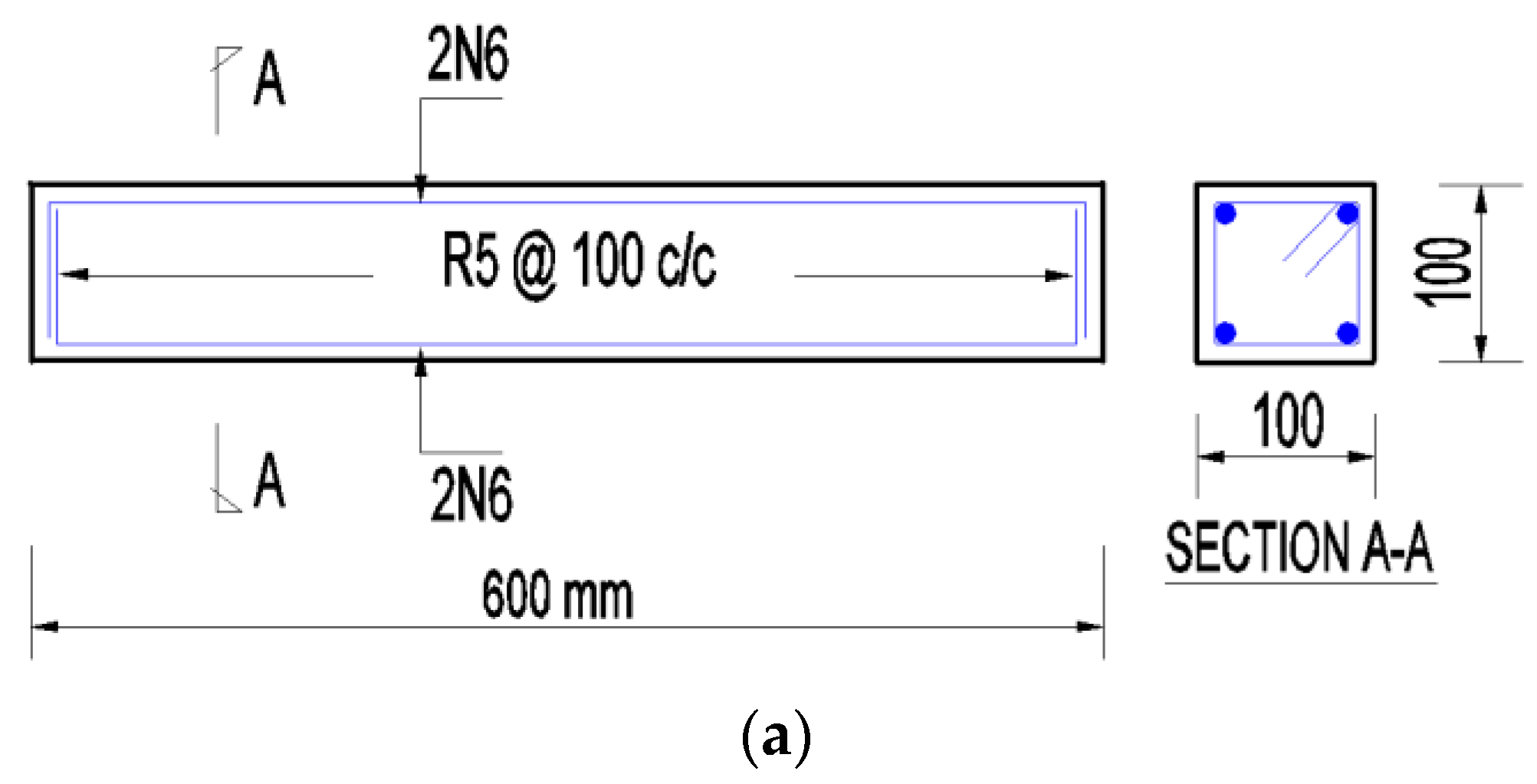
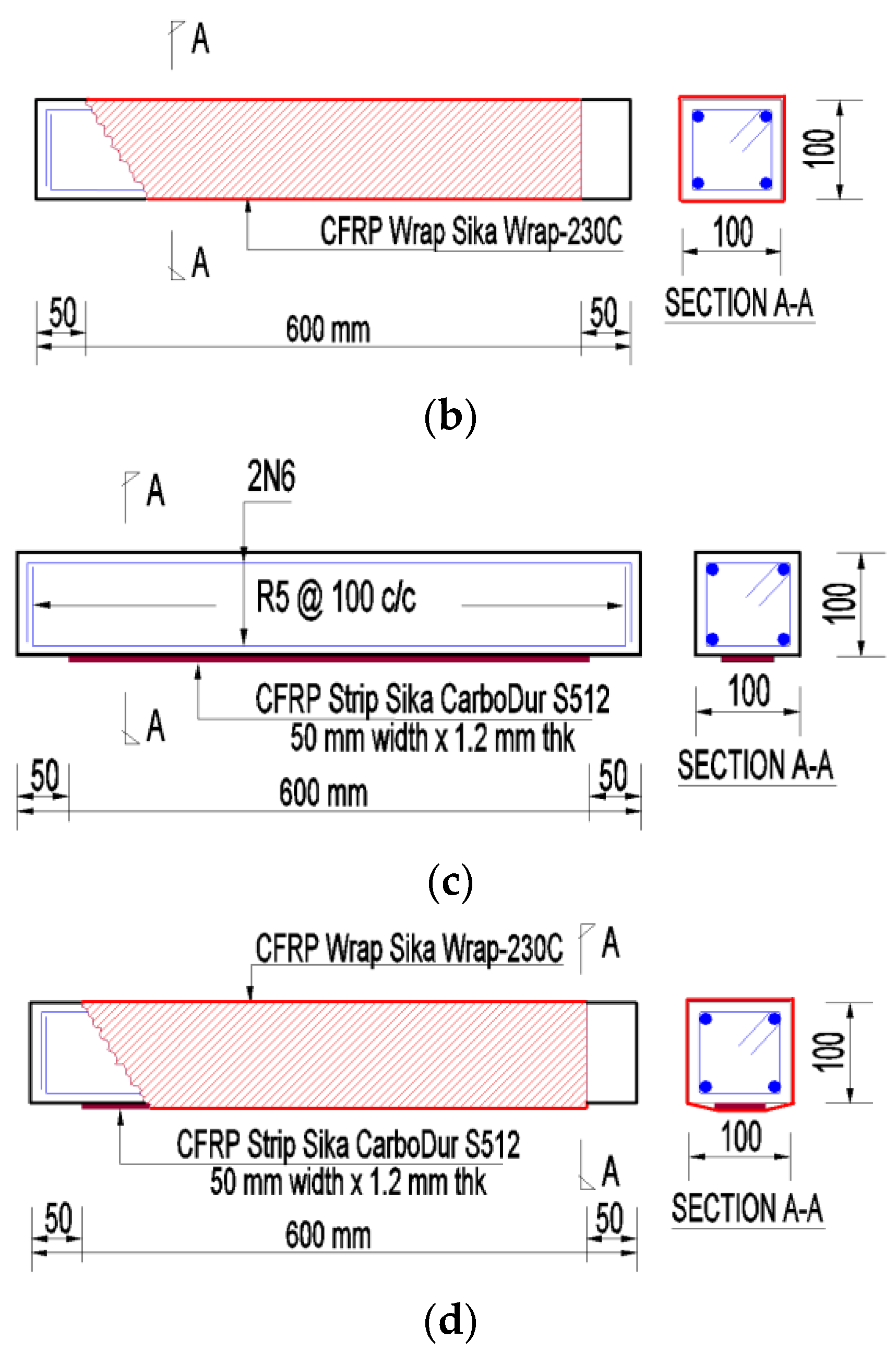

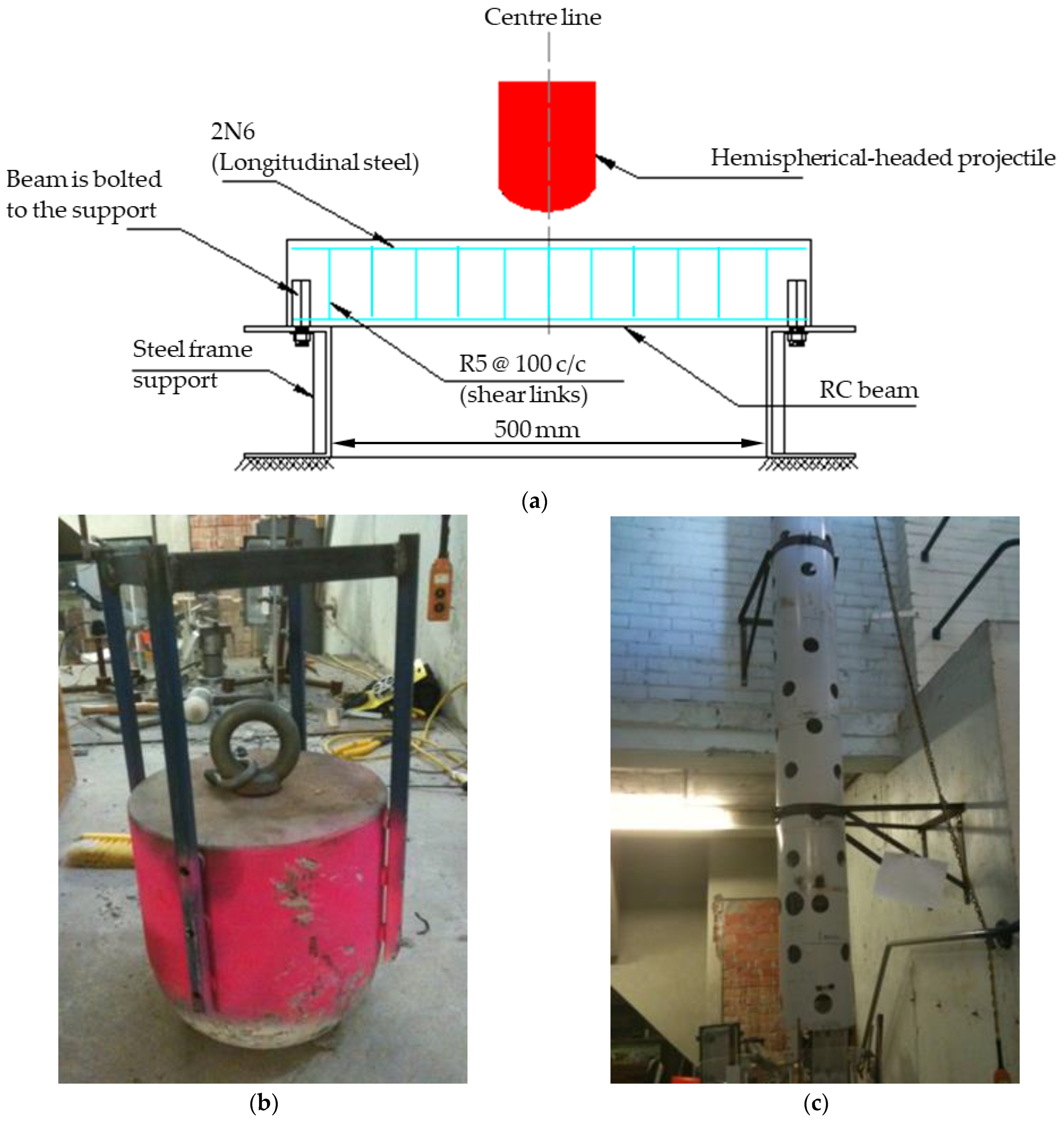
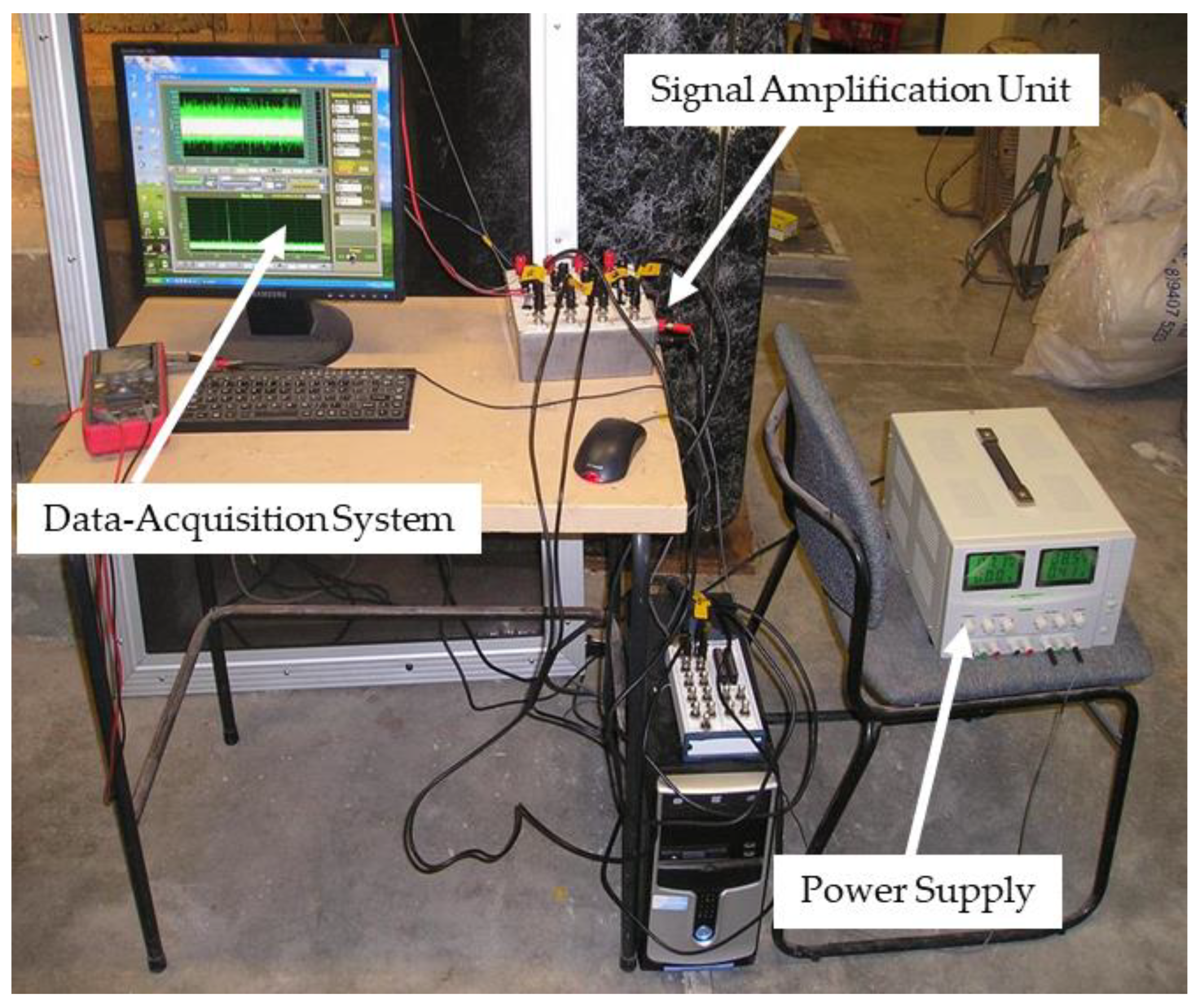

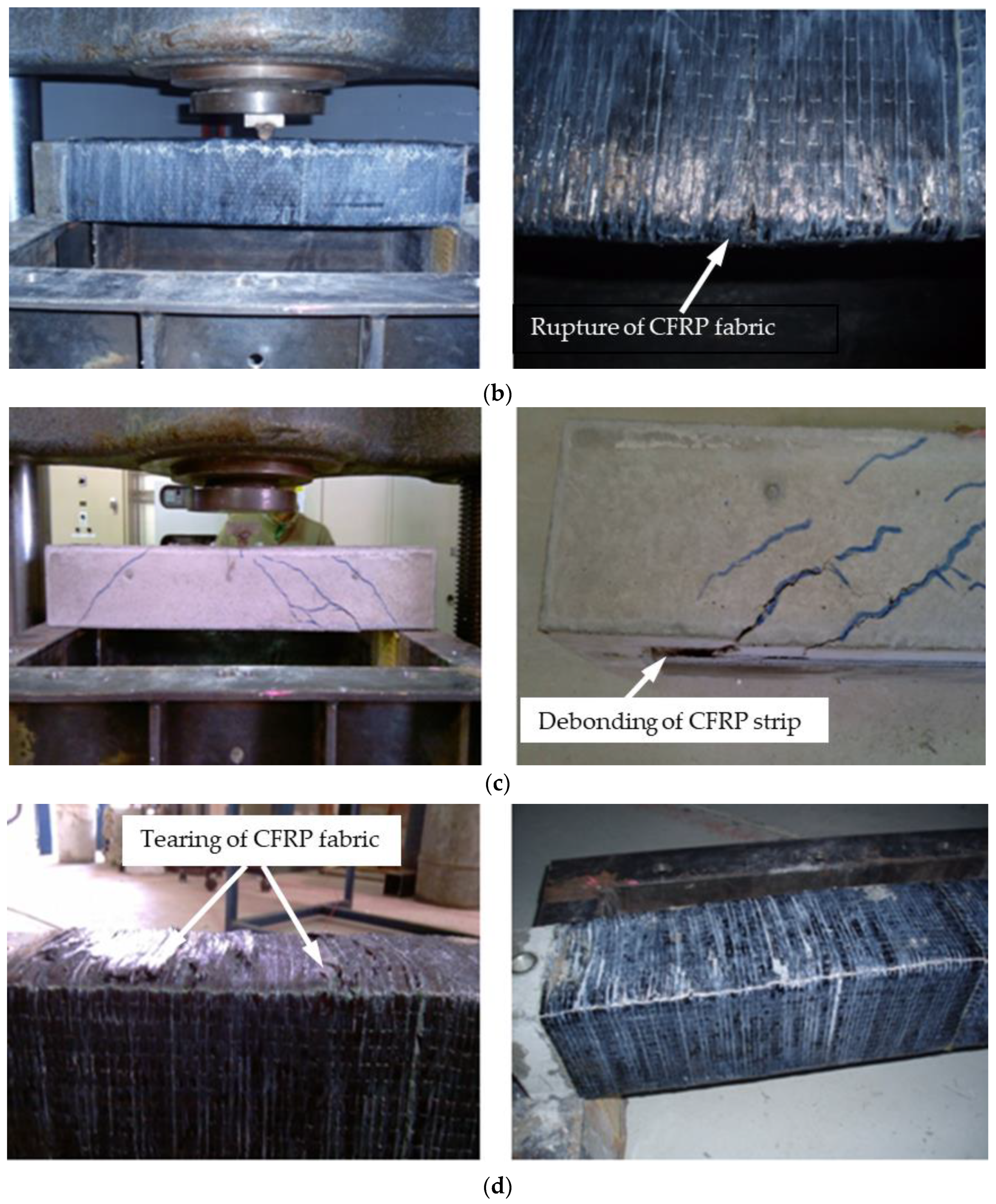


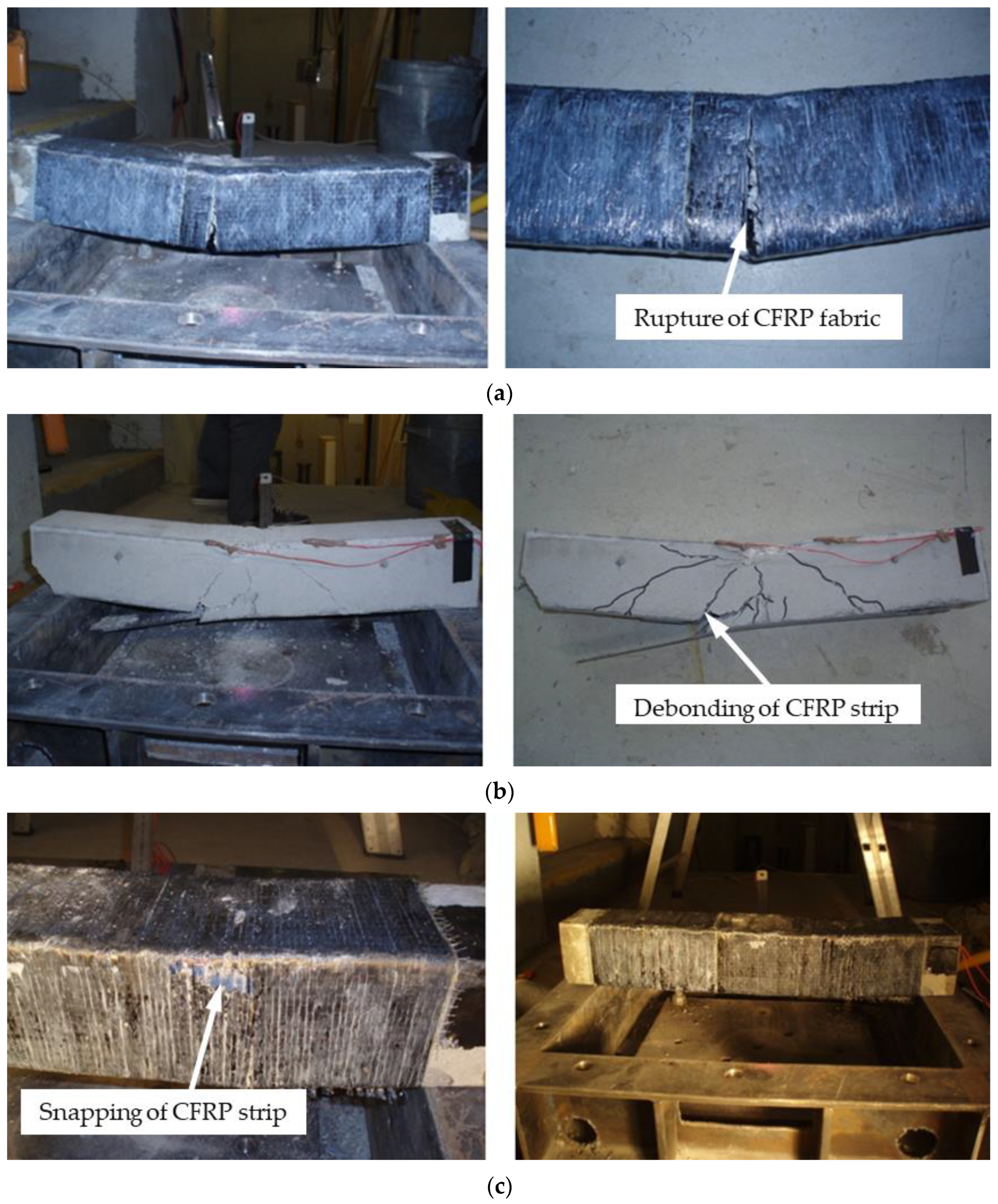
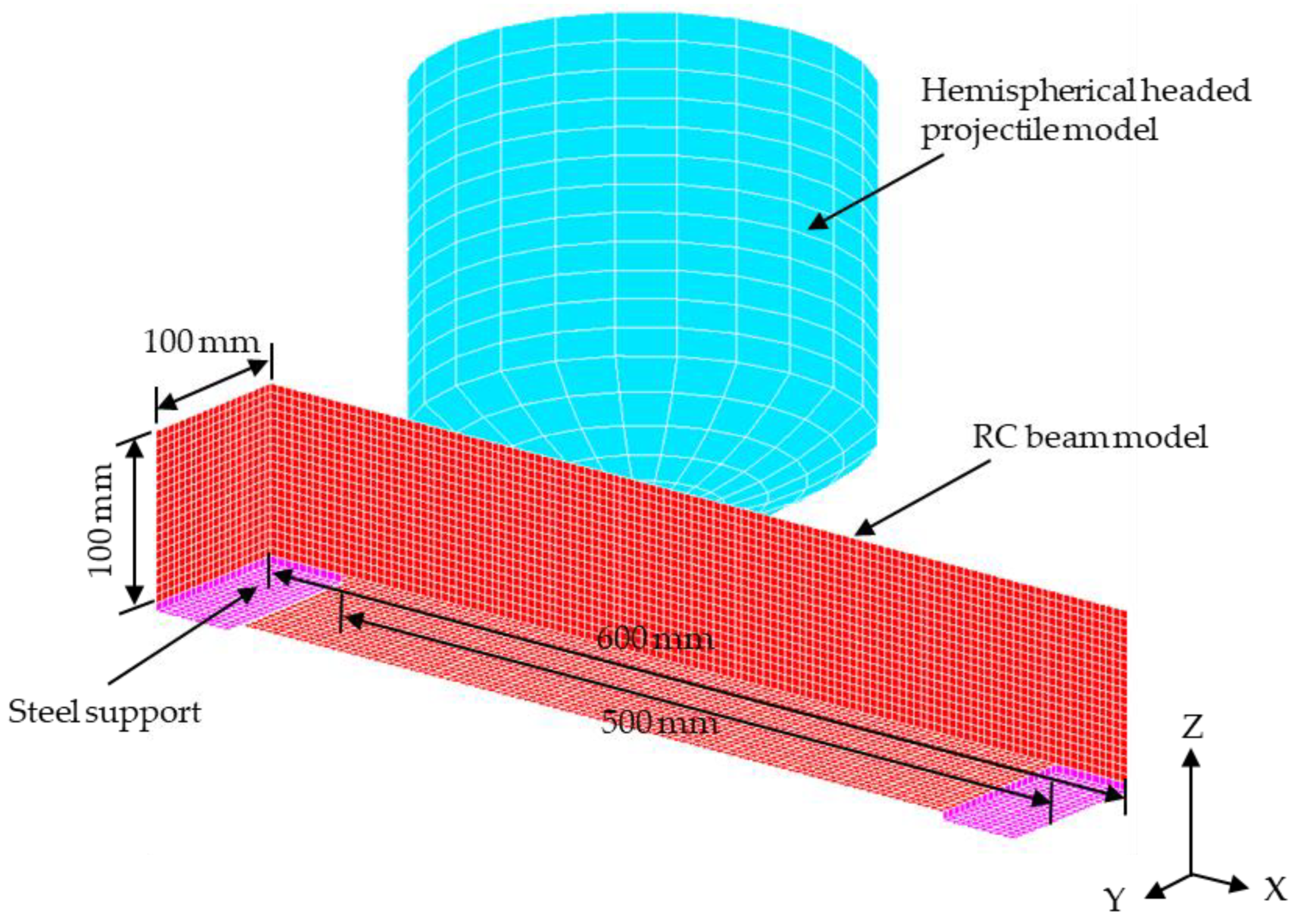
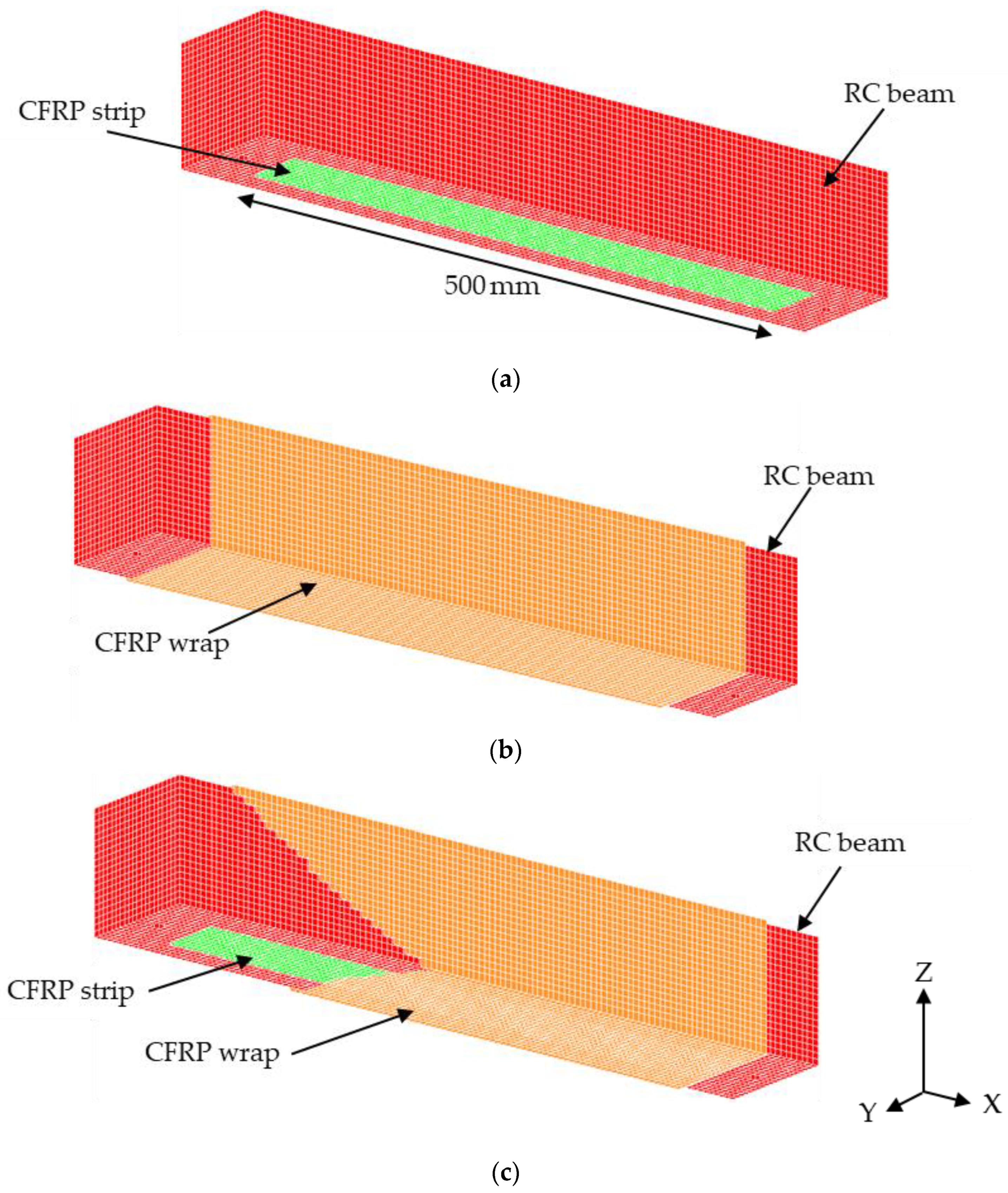

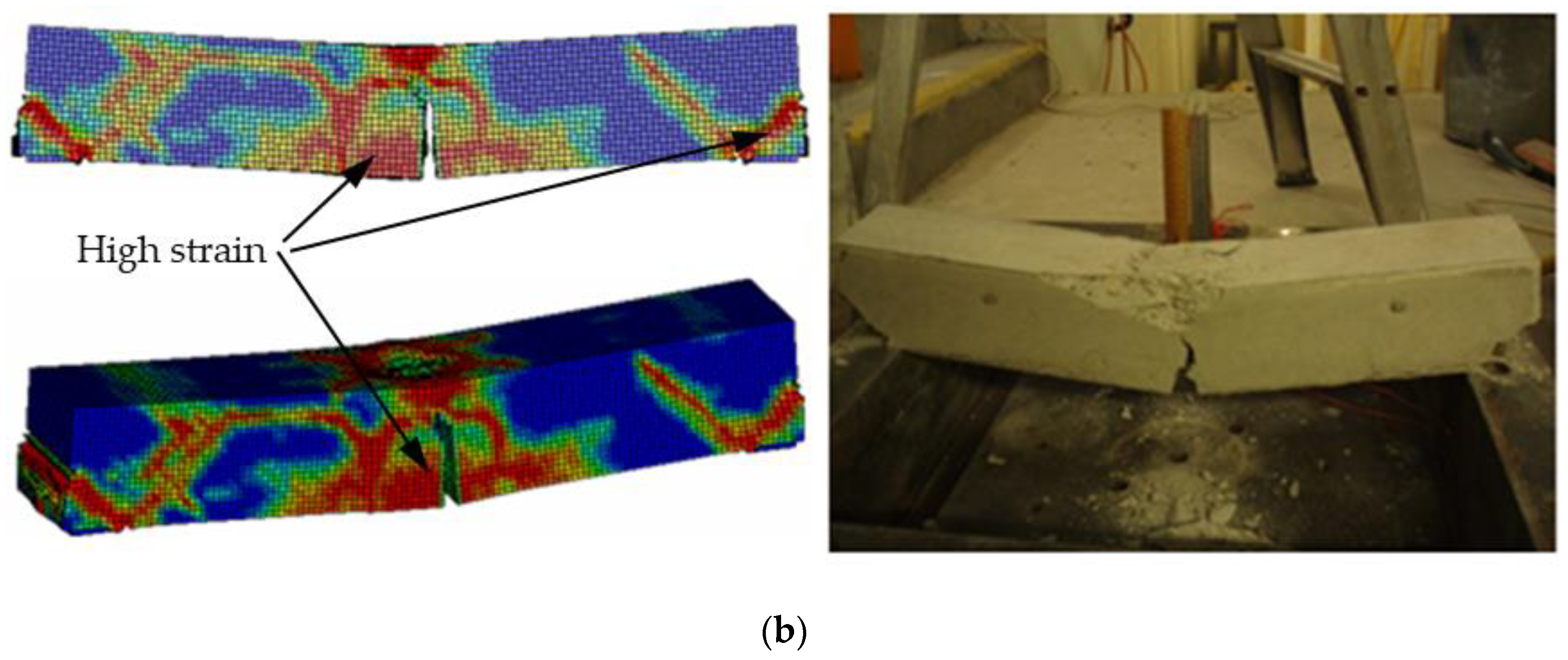
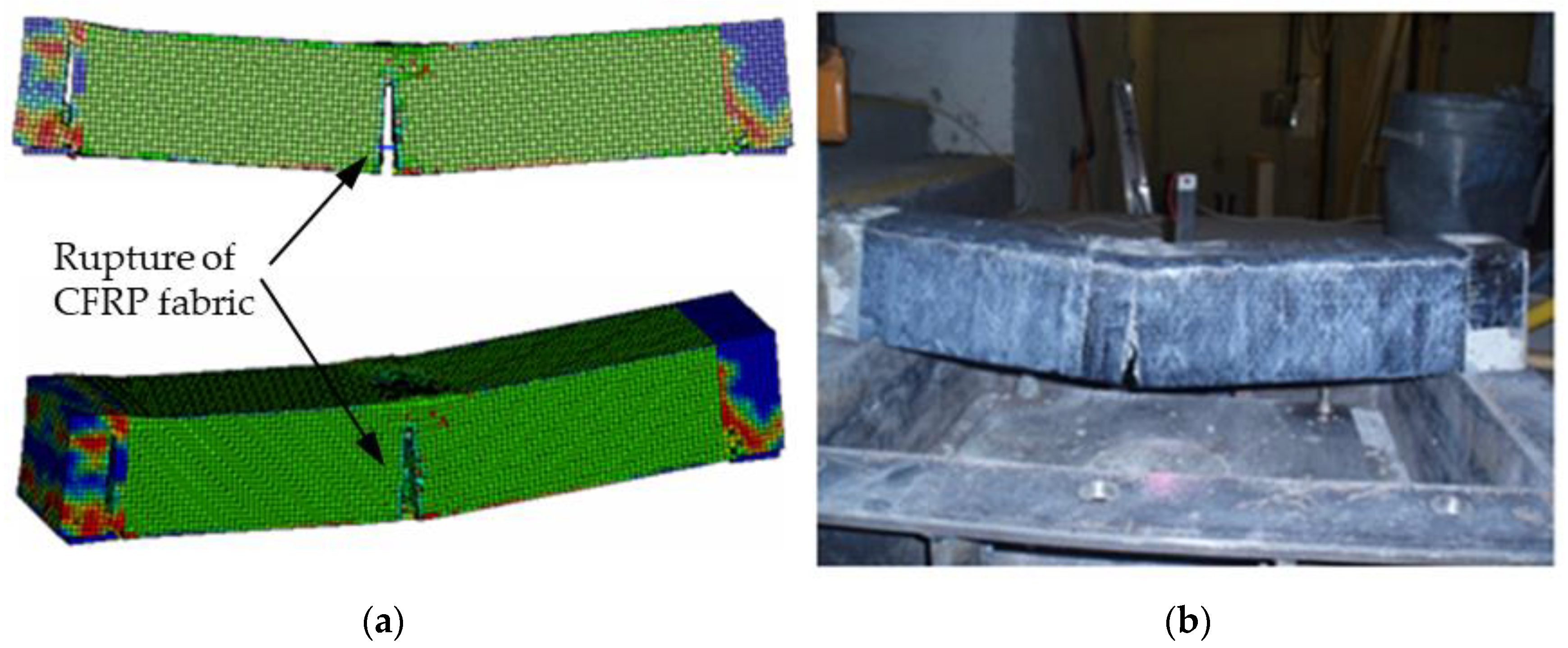

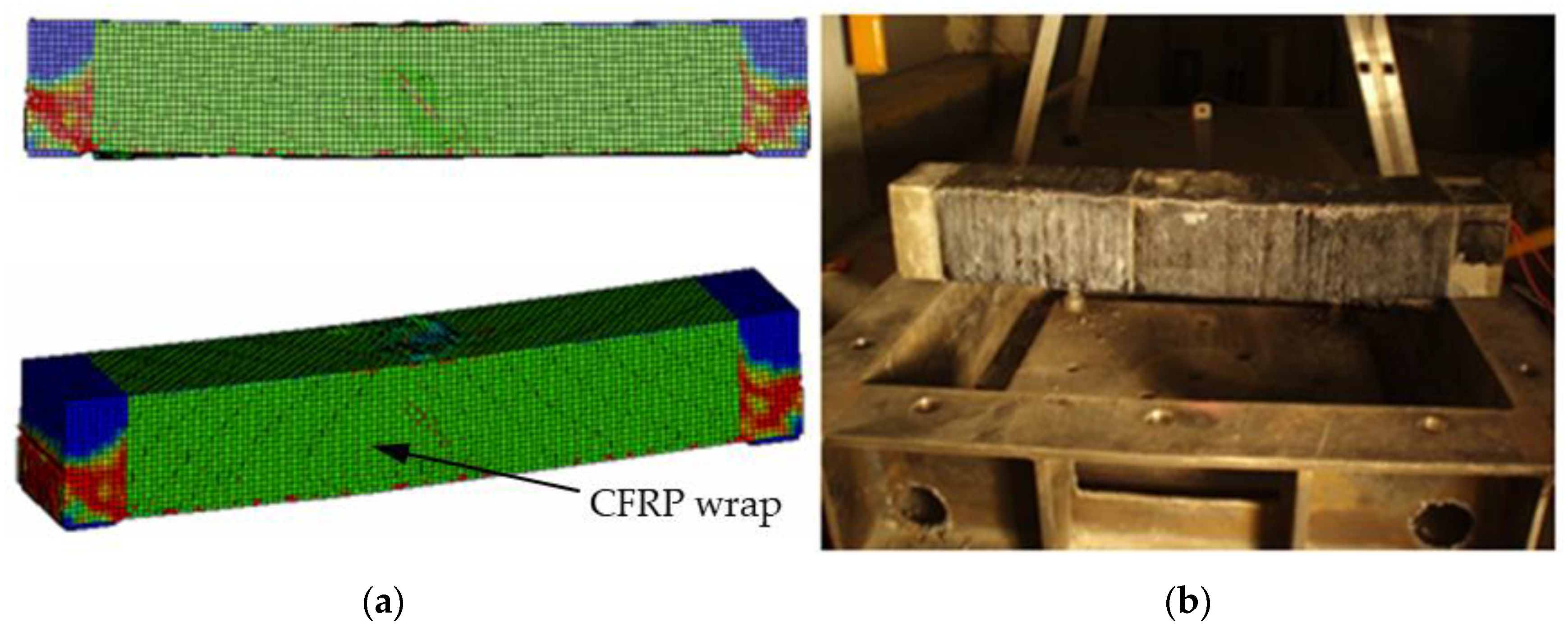
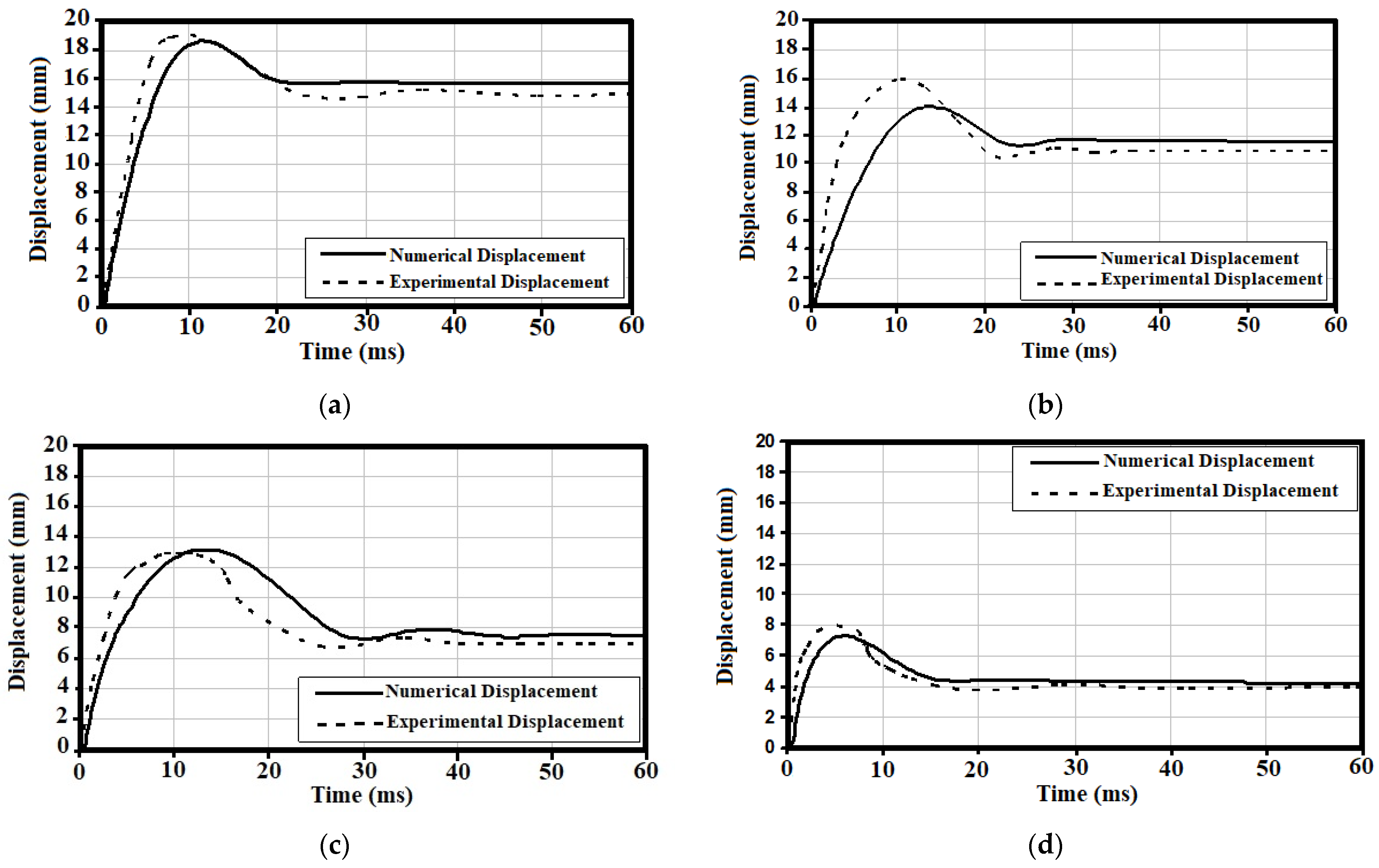
| Group Code | Description |
|---|---|
| B1 | Control: No strengthening |
| B2 | RC beam strengthened with one layer of CFRP (Sika Wrap-230C, Sika, Baar, Switzerland) wrap of 0.13 mm thickness |
| B3 | RC beam strengthened with one layer of 50 mm width and 500 mm long CFRP (Sika CarboDur S512, Sika, Baar, Switzerland) strip of 1.2 mm thickness provided by SIKA Australia PTY LTD, Wetherill Park, Australia, to the tension side of the beam |
| B4 | RC beam strengthened with the CFRP strip and then wrapped as described above |
| Concrete | (MPa) | (MPa) |
|---|---|---|
| B1, B1a, B1b | 37.78 | 5.97 |
| B2, B3, B4 | 35.42 | 5.59 |
| Steel | Yield stress (MPa) | Young’s modulus (GPa) |
| Longitudinal steel | 506 | 200 |
| Shear stirrup | 305 | 200 |
| CFRP [39] | Tensile strength (MPa) | Young’s modulus (GPa) |
| Sika CarboDur S512 | 2800 | 165 |
| Sika Wrap-230C | 3500 | 230 |
| Epoxy [39] | Tensile strength (MPa) | Young’s modulus (GPa) |
| Sikadur-30 | 31 | 11.2 |
| Sikadur-330 | 30 | 4.5 |
| Specimens | Maximum Load (kN) | Deflection (mm) | Flexural Strength (MPa) | Improvement in Strength (%) |
|---|---|---|---|---|
| B1 | 33.07 | 8.00 | 29.76 | N/A |
| B2 | 36.92 | 8.77 | 33.22 | 11.64 |
| B3 | 41.27 | 8.24 | 37.15 | 24.80 |
| B4 | 61.14 | 10.29 | 55.03 | 84.88 |
| Tested Beam | Drop Height (m) | Average Deflection (mm) | Average Residual Deflection (mm) | Maximum Deflection Reduction (%) | Residual Deflection (%) |
|---|---|---|---|---|---|
| B1 | 0.6 | 7 | 4.5 | - | - |
| 1 | 19 | 15 | - | - | |
| B2 | 1 | 16 | 11 | −15.79 | −26.67 |
| B3 | 1 | 13 | 7 | −31.58 | −53.33 |
| B4 | 1 | 8 | 4 | −57.89 | −73.33 |
| Tested Group | Drop Height (m) | Experimental Impact Velocity (ms−1) | Theoretical Impact Velocity (ms−1) |
|---|---|---|---|
| B1a | 0.6 | 3.32 | 3.43 |
| B1b | 1 | 4.29 | 4.43 |
| B2 | 1 | 4.30 | 4.43 |
| B3 | 1 | 4.28 | 4.43 |
| B4 | 1 | 4.34 | 4.43 |
| Beam Code | Maximum Displacement (mm) | Differences (%) | |
|---|---|---|---|
| Numerical | Experimental | ||
| B1 | 18.7 | 19 | −1.6 |
| B2 | 14 | 16 | −12.5 |
| B3 | 13.2 | 13 | 1.54 |
| B4 | 7.3 | 8 | −8.76 |
Disclaimer/Publisher’s Note: The statements, opinions and data contained in all publications are solely those of the individual author(s) and contributor(s) and not of MDPI and/or the editor(s). MDPI and/or the editor(s) disclaim responsibility for any injury to people or property resulting from any ideas, methods, instructions or products referred to in the content. |
© 2024 by the authors. Licensee MDPI, Basel, Switzerland. This article is an open access article distributed under the terms and conditions of the Creative Commons Attribution (CC BY) license (https://creativecommons.org/licenses/by/4.0/).
Share and Cite
Mussa, M.H.; Mutalib, A.A.; Hao, H. Experimental and Numerical Study of Carbon Fibre-Reinforced Polymer-Strengthened Reinforced Concrete Beams under Static and Impact Loads. Fibers 2024, 12, 63. https://doi.org/10.3390/fib12080063
Mussa MH, Mutalib AA, Hao H. Experimental and Numerical Study of Carbon Fibre-Reinforced Polymer-Strengthened Reinforced Concrete Beams under Static and Impact Loads. Fibers. 2024; 12(8):63. https://doi.org/10.3390/fib12080063
Chicago/Turabian StyleMussa, Mohamed H., Azrul A. Mutalib, and Hong Hao. 2024. "Experimental and Numerical Study of Carbon Fibre-Reinforced Polymer-Strengthened Reinforced Concrete Beams under Static and Impact Loads" Fibers 12, no. 8: 63. https://doi.org/10.3390/fib12080063





